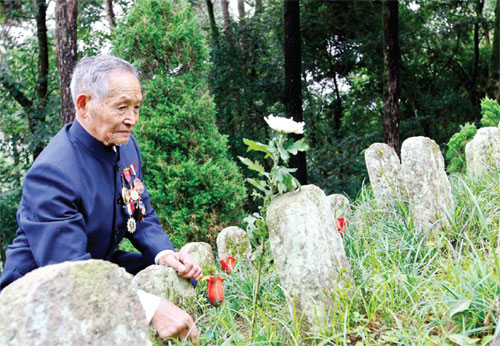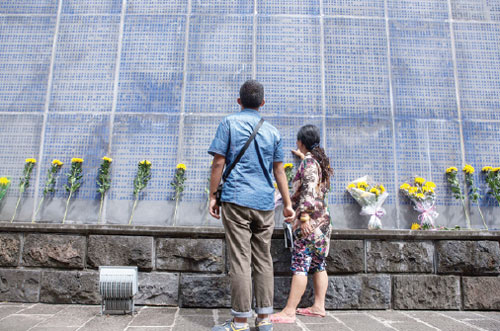The beginning of the end
Updated: 2015-08-19 07:45
By He Na(China Daily)
|
|||||||||||
The Chinese victory in a remote mountainous spot in southwestern China signaled the turning of the tide and the start of the endgame for the Japanese occupation of the country, as He Na reports from Tengchong, Yunnan province.
From the summit of Mount Laifeng, or "Rising Phoenix Mountain", one can see the whole of Tengchong, a county in southwestern Yunnan province, which sits along China's remote border with Myanmar.
Today, the mountain spot, a well-known tourist resort and center for weekend activities such hiking, trail-running and camping, seems idyllic, but a little more than 70 years ago it was a living hell.
At the lower levels of the mountain, the only indication of the area's turbulent history is a small commemorative stone that bears the inscription: "The main Anti-Japanese Battlefield in Dianxi" (the Chinese abbreviation for western Yunnan).
At the higher levels, however, the densely wooded hillside is pock-marked with numerous trenches, bunkers, tunnels and shell craters - old scars that tell of the fierce battles that took place during the War of Resistance Against Japanese Aggression (1937-45).
According to Li Zhicai, a researcher at the Baoshan City Museum, the defenses were dug and built by the Japanese after they occupied Tengchong in May 1942, and the interlocking subterranean network was so complex it took two years to build.
"Nowadays the summit is covered by huge, dense trees, but during the war the Japanese cut down the trees on the summit to improve visibility and make the mountain a better defensive position," Li said.
"In July 1944, the China Expeditionary Force carried out a massive counterattack in Dianxi, launching two major offensives to capture the mountain. The victory cost the lives of 10,000 CEF soldiers," he said.
The anti-fascist front
The outbreak of the war in the Pacific in December 1941 saw the Japanese launch attacks across Southeast Asia. They quickly occupied several countries, including the Philippines, Thailand and Malaysia, and also threatened the safety of Myanmar (then known as Burma) and Southwest China.
"On Jan 1, 1945, China, the United States and 24 other countries reached an agreement to establish an international anti-fascist front. In March, the 100,000-strong CEF was formed to fight alongside the British army in Myanmar and to defend China's southwestern regions," said Wu Baozhang, professor of history at Yunnan Normal University.
"However, misunderstandings and mutual suspicions hindered the operations, and the expedition failed. The CEF was forced to with draw to India, which meant Myanmar and large parts of western Yunnan fell into Japanese hands," he added.
The situation entered a stalemate as Chinese and Japanese forces faced each other across the Nujiang River until the middle of 1944.
"May 1944 to January 1945 was the time of the great counterattack. About 200,000 soldiers, mainly from the (Kuomintang) 11th and 20th group armies, re-formed the CEF to launch a counterattack. After more than eight months of fierce fighting, the CEF successfully performed a pincer movement with US troops and retook Mongyu, a town in Myanmar, on Jan 27. That marked the final victory in the war in Dianxi," Wu said.
The Battle of Laifeng Mountain is one of the best-known encounters from the period.
According to Li, military archaeologists began excavating the mountain's old defenses in November. "So far we have excavated four Japanese frontline positions, which have been codenamed 'Pine', 'Bamboo', 'Plum' and 'White Tower'," he said.
"In addition to bomb craters, three trenches and a number of pits used by the CEF, we have found many spent bullets, shell cases and bombs. Some of them are displayed at the Dianxi Anti-Japanese Memorial Hall," he added.
The differing sizes, shapes, directions and depths of the trenches suggest that they had different functions, indicating that the Japanese had prepared fully for the forthcoming battle, according to Li.
"Thanks to the valor of the men involved and the cover provided by the US air force, the Japanese were kicked off the mountain after three days of intense fighting," he said.
"The mountain was the Japanese army's last line of defense at Tengchong, and the retaking of the mountain was a major step toward recapturing the entire county. Tengchong was founded during the Ming Dynasty (1368-1644), and most of the buildings were made from stone, not wood. Once the Japanese had fortified the buildings, the county became a fortress. The CEF paid a high price in deaths and casualties to regain control," he said.
A cemetery at the northern foot of Laifeng Mountain, about 200 kilometers from the China-Myanmar border, contains rows of tombstones that bear the names and ranks of the dead.
The 53,300-square-meter grave-yard, which was opened in 1945, is the final resting place of the 10,000 CEF troops and 19 US liaison officers who died in the battle to retake Tengchong. Their bodies were cremated en masse, and the ashes were buried on the summit near a small monument.
Wu said the victory inspired the CEF troops. "Tengchong was the first county to be recaptured from the Japanese during the invasion, which was a great boost to the soldiers' confidence."
The victory was anything but easy, though. The two armies engaged more than 40 times in 127 days, resulting in the deaths of 7,757 Japanese troops.
The frequent visitor
The cemetery is now a major attraction and regularly draws large numbers of locals and tourists.
Every few days, CEF veteran Lu Caiwen visits the graveyard to lay chrysanthemums in memory of his fallen comrades. The 90-year-old graduate of the Whampoa Military Academy explained that the classmates who sat on his left and right were both killed in the war.
"I still miss them," he said.
Lu joined the Kuomintang army at age 16 after witnessing several atrocities committed by enemy soldiers in Tengchong. After enlisting, he was sent to a military training school in Dali, Yunnan, which had been founded by the Kuomintang National Government Military Committee, but was later merged with Whampoa.
"The training course was scheduled to last for three years, but because of the war it was shortened to 12 months. After graduation, I was sent to work for the 11th army's intelligence unit to collect information about the Japanese military deployments," he recalled.
While other people were trying to get as far away as possible from the Japanese, Lu and his comrades traveled in the opposite direction, often undertaking extremely hazardous missions.
"Once, we were assigned to investigate the conditions at a Japanese position near Longling county. We had drawn very close when we noticed a large number of Japanese soldiers. We were discovered by a patrol and fought at close range. Luckily I was uninjured," he said.
The intelligence work required a good brain and great courage.
"We were at our wits' end trying to assess the deployment of the Japanese in Tengchong, so we had no option but to interrogate a man who was suspected, correctly, of being a dangerous collaborator," Lu said.
As he prepared to enter the man's house, Lu realized he might not come out alive. "I was very nervous, but I forced myself to calm down. After quite a while, I persuaded him to hand over details of the current military situation by assuring him that we would protect him after the Japanese had been expelled from Tengchong," he said.
The interrogation proved far more successful than anyone had dared to imagine because the man provided a great deal of additional information in the days that followed, and Lu was promoted to lieutenant.
Having witnessed the horrors of war firsthand, Lu applied for a discharge after the relief of Tengchong, and spent the next four decades as a teacher, retiring in 1987.
"I don't hate the Japanese people, because many Japanese were also killed in the war. But I hate the Japanese government and its attitude toward the war," he said.
"It's a sign of real progress that the government has recognized our (the Kuomintang soldiers') contribution to the war against the Japanese. I hope the young people will remember history and learn to cherish peace."
Yang Wanli and Tang Yue contributed to this story.
Contact the writer at hena@chinadaily.com.cn
|
Lu Caiwen, a China Expeditionary Force veteran, often visits his fallen comrades at a memorial cemetery in Tengchong, Yunnan province. Xue Dongmei / Xinhua |
|
An old defensive position on Laifeng Mountain in Tengchong. |
|
Visitors read the names of the heroes of the China Expeditionary Force at the cemetery. Chen Junqing / Xinhua |
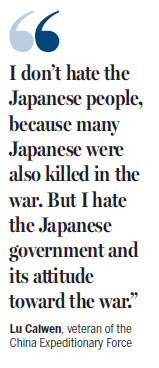
(China Daily 08/19/2015 page6)
Today's Top News
Six Chinese nationals confirmed dead in Bangkok blast
Rain in Tianjin poses no health risk, says official
Two HK women among four Chinese killed in Bangkok blast
South Korea's Park has good reason to attend Sept 3 parade
Yuan move is likely to deliver positive results in long term
Sodium cyanide in Tianjin to be cleared
Premier Li pledges thorough investigation into deadly blasts
Bomb in Thai capital kills 19, including 3 Chinese nationals
Hot Topics
Lunar probe , China growth forecasts, Emission rules get tougher, China seen through 'colored lens', International board,
Editor's Picks

|
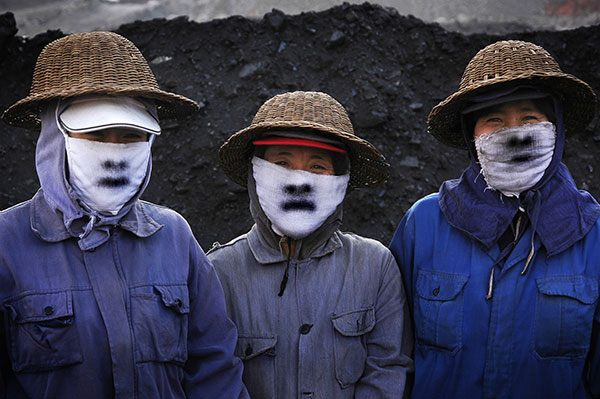
|

|
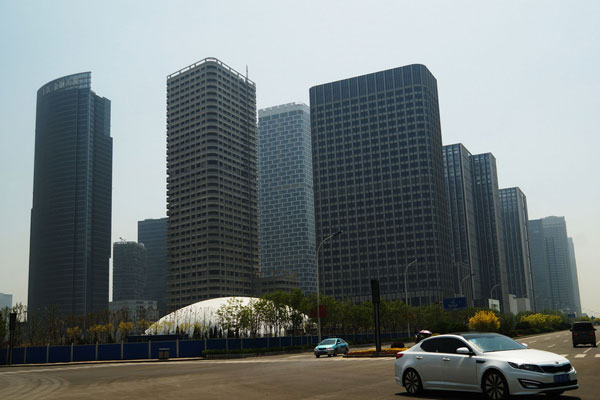
|
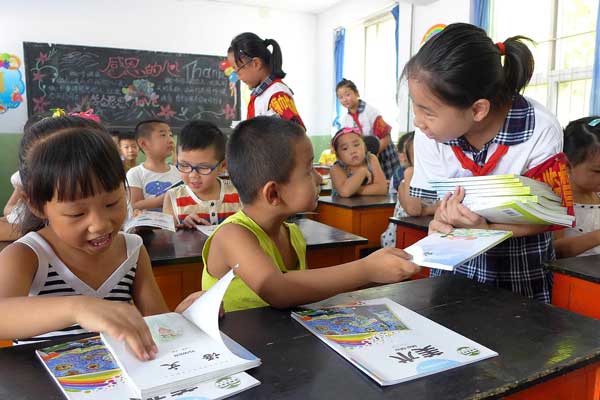
|

|
